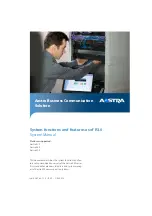
A
A-10
IP4700 Installation and Service Guide
Technical Specifications and Operating Limits
Battery Tests
Battery Self-Discharge
Times
When you store an SPS, the battery charge level naturally decreases
over time. This is characteristic of all rechargable batteries. The rate of
self-discharge depends on temperature. Lower storage temperatures
are desirable since the self-discharge rate is lower. The following
graph shows how the remaining charge decreases over time at
different temperatures.
Figure A-1
Typical SPS Self-Discharge Levels at Different Storage Temperatures
Internal
Within 60 minutes after powerup and approximately every 2 weeks
thereafter, the SPS itself performs a light test on the batteries. This test lasts
a few seconds. It does not verify battery capacity but does check connectivity
and functionality. This test is transparent to other components in the array. If
an actual power failure occurs during the test, the test is terminated and the
unit goes into On-Battery mode.
Full
At each storage system startup, the system software initiates a full power
test. During the test, the system dumps write cache and allows the SPS to
stay on for its entire 90-second period.
The system initiates a full test when the SPS is On-Line and fully charged. If
the batteries are charging at test time, the system defers the test until the
next programmed time.
100
80
60
40
20
0
3
6
9
12
15
18
Storage time (months)
20 degrees C (68 F)
30 degrees C (86 F)
40 degrees C (104 F)
10
30
50
70
90
Avoid allowing the battery
to discharge below this
level to allow full recharge
within the SPS time limit.
Remaining capacity (%)
Summary of Contents for IP4700
Page 4: ...IP4700 Installation and Service Guide iv ...
Page 8: ...IP4700 Installation and Service Guide viii Contents ...
Page 12: ...xii IP4700 Installation and Service Guide Preface ...
Page 18: ...xviii IP4700 Installation and Service Guide Warnings and Cautions ...
Page 60: ...2 2 24 IP4700 Installation and Service Guide Installing an IP4700 ...









































